The K6STI Loop at HC1PF
A further search for noise fighting…but read to the bottom
One of my oldest friends and most successful Topbander, John G3PQA, was complaining about noise growing even in his UK location and was taking into consideration the K6STI loop. This is a specialized receiving antenna, omni directional and thus with a low RDF, but with low sensitivity to vertical polarized noise and, my worst problem, to local AM broadcasting signals.
This loop has been fully described in two articles in QST, Sep. 1995 by Brian Beezley, K6STI and Edwin Andress, W6KUT.
After deeply reading these articles I went to EZNEC and, with the cooperation of G3PQA, modeled my own loop with the real possible dimensions: a perfect square with 9.25 meters per side and 6 m. high, to substitute the previous horizontal, resistance loaded, loop. The innovative two feed points 180 degrees out of phase produce a 44 degr. elevation lobe with horizontal polarization, as desired at my location.

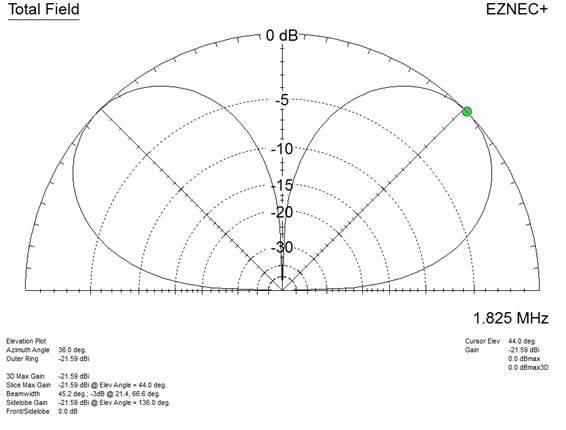
The source data at the 450 lines junction indicated the impedance as R = 3.5 + j 370 ohms and thus I calculated the matching system: a capacitor of 235 pF to null out the reactance followed by a 4:1 transformer i.e. only one turn on the antenna side and four turns on the coax side of a binocular BN73-202, as advised by John G3PQA who tested back to back several transformers.
The Eznec SWR function, after the insertion of the complete feed system, produced the following graph, which shows a critical tuning with an extremely sharp BW:
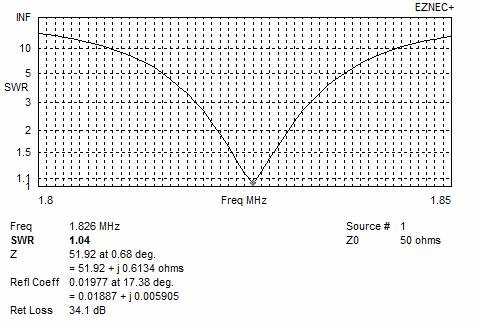
The most boring work was the ladder line construction: from the smallest available electrical raceways I cut and drilled 100 insulators, 5 cm. each and placed every 15 cm. to get the 450 ohms impedance (#14 wire with 3.2 mm. separation).
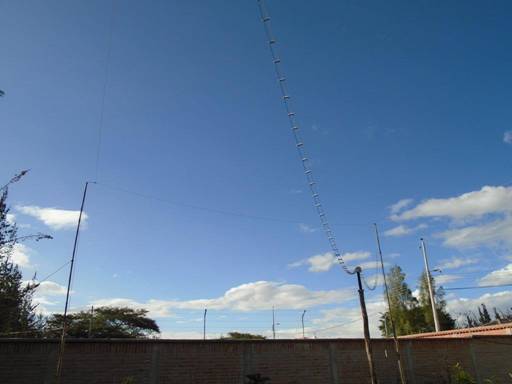
John was a bit ahead of me with the project and, after blowing his analyzer during the first measurements, suggested me to add a 5/50 Kohm resistor between the loop and the earth for static discharge. So I put a 10 K ohm 4 watt resistor across the transformer, connecting the loop to the earth via the coax shield.
With the antenna analyzer I made some measurements on a surplus ceramic compression trimmer (marked ZA2009) and found its range from 125 pf to 580 pF with 4 turns; fixed at 235 pF – according to Eznec – and put in the box as a starting point.

Like him, I began the readings with my AEA CIA analyzer on the ladder line junction: they were unreliable and not stable, but in the range of R 600 - 800 ohms and X around j500 (the analyzer does not work well so far from 50 ohms).
Than I measured between the capacitor and the xfmr : R = 7 X = j10. At the coax connector: R = 126 X = j212 .
So, I said, it must be necessary to better null out the reactance and a less transformer ratio. I reduced the primary from 4 to 3 turns: it should be ok to go from 7 to 50 ohms, but not enough. Now the best achieved on 1.825 was R = 88 and X = j60. Back to measure between capacitor and xfmr: R = 8 and X =j15
With such a low impedance everything is sharp and critical and a few ohms of reactance, which usually do not care on the high impedance loops, like flags and pennants, in this case produce unexpected transformations and results.
As it was impossible to completely null out the reactance by means of the 125-580 pF compression trimmer, I put in parallel another small one 3-20 pF and with its smooth adjustment immediately got X = 0.
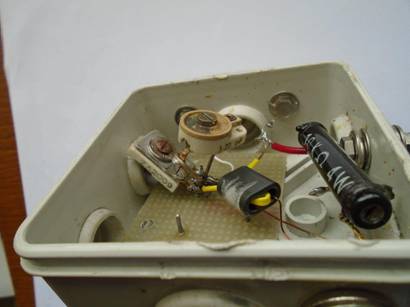
But now the reading of the resistive component grew up to 14.5 ohms. At the coax connector, after the 3:1 transformer, the reading worsened at R = 118 and X = j185.
So the xfmr had to be calculated again, and I reduced a further turn on the secondary. Now the definitive turns are: ONE turn on the primary and only TWO turns on the secondary (coax side) on a binocular BN73-202.
PERFECT: now the readings at the coax socket were: R = 47 and X = 0 on 1.850 KHz; by smooth regulation of the second trimmer the null was carried down where wanted on 1.825.
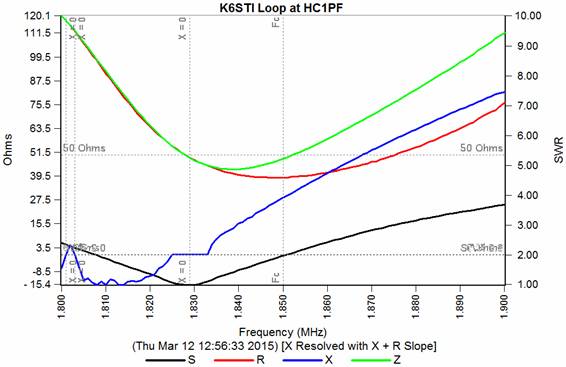
Anyway this is the last comment by G3PQA: “… we do not really like the 73 binocular transformers for these low impedances, I do not recommend them for this use because their response peaks at 250kHz, it is only that we are making the best out of the materials available and a 0.5dB loss on 160m for this use is perfectly acceptable anyway! Luckily I can measure the loss with a VNA but am sure that some expert can design a better transformer with a wider HF response and without the peak at VLF.”
For sure it was a good exercise on antenna’s tuning and matching, but now let’s see if it was worth and really works on the air!
The first night of tests was quite disappointing: the only usable antenna was still the rotatable Flag. The K6STI loop seems to produce only noise like all the other antennas. The following are the noise graphs taken around noon on the SDR-IQ receiver

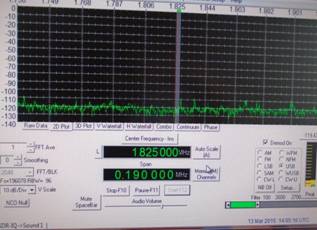
K6STI Loop: -105 dB Rot. Flag-: -119 dB

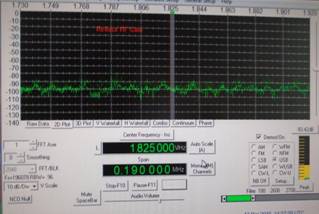
BOG unterminated: -100 dB BOG terminated: -93 dB

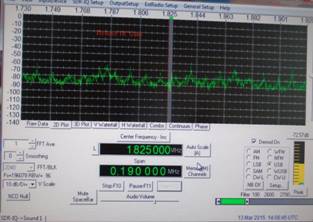
No antennas: -126 dB Inverted L: -72 dB
So the noise level on the K6STI loop is 33 dB lower than on the TX antenna, but the old rot. Flag is still 14 dB better!
All the feed lines are deep buried with common mode chokes and ground rods. I disconnected and checked the 96 m. coax going to the K6STI loop and it appears to be ok:


Loop
feedline (96 m. RG213): -122 dB same feedline w. shield disconnected: -79 dB
Now I will keep this loop under test for some days to verify if I will take any advantage on the high angles supposed to be dominant at these low latitudes, but I’m afraid it has been a waste of time…once more!
Quito, March 13 2015
Probably the problem is my electric fence: the loop is inside a big coil of 5 turns, each 183 m. long, as shown in following sketch.
According with the K6STI theory the noise is vertically polarized and the horizontal polarization helps to reduce it, but in my particular case the close coupling with the big horizontal coil is much more dominant and introduces much more noise, whatever is its polarization!

Quito, March 14 2015
So back to EZNEC and added the electric fence to the model. The “antenna view” picture shows the huge currents induced in the fence wires:
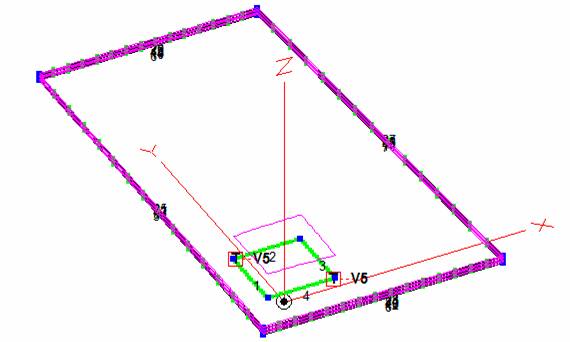
The resulting pattern is completely destroyed, with just a straight up lobe instead of the 45 degrees ones.
The K6STI loop has been transformed in a DIFFERENT horizontal loop, which corresponds to the realty and explains the high level of noise: more than 15 dB of gain, compared with the original design (blue trace).

The conclusion is that definitely I must rethink everything and go back to vertical polarized receiving antennas!
Quito, March 15 2015
